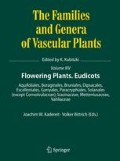Abstract
Annual or perennial, erect, branched herbs or subshrubs, glabrous or pubescent; nodes unilacunar. Leaves opposite, sessile to subsessile, exstipulate, simple, ovate to linear, entire. Inflorescences axillary, of paired, small hermaphrodite, actinomorphic flowers. Perianth with distinct pentamerous calyx and corolla; calyx lobes valvate; petals free, valvate, obovate-spathulate, entire to crenate-dentate, sometimes hairy at the base inside; stamens 5, inserted on the margin of an epigynous disk, antesepalous, filaments free, subulate, glabrous or sparsely hairy, sometimes with scale-like appendage at the base; anthers 2-thecous, introrse, dorsifixed; ovary inferior, campanulate to subglobose, 2–3-carpellate, syncarpous, unilocular, with 2–3 distinct, glabrous or sparsely hairy stylodia, stigmata capitate; ovules numerous, attached to two pendulous placentas, anatropous, bitegmic, tenuinucellate. Fruit a subglobose or obovoid capsule, apically with 2–3 valves. All floral parts except anthers persistent. Seeds numerous, minute, oblong.
Access this chapter
Tax calculation will be finalised at checkout
Purchases are for personal use only
Selected Bibliography
Al-Shammary, K.I.A., Gornall, R.J. 1994. Trichome anatomy of the Saxifragaceae s.l. from the southern hemisphere. Bot. J. Linn. Soc. 114: 99–131.
Albach, D.C., Soltis, P.S., Soltis, D.E., Olmstead, R.G. 2001. Phylogenetic analysis of asterids based on sequences of four genes. Ann. Missouri Bot. Gard. 83: 163–212.
APG III (Angiosperm Phylogeny Group) 2009. An update of the Angiosperm Phylogeny Group classification for the orders and families of flowering plants: APG III. Bot. J. Linn. Soc. 161: 105–121.
Behnke, H.-D. 1988. Sieve element plastids and systematic relationships of Rhizophoraceae, Anisophyllaceae, and allied groups. Ann. Missouri Bot. Gard. 75: 1387–1409.
Bell, C.D., Soltis, D.E., Soltis, P.S. 2010. The age and diversification of the angiosperms re-revisited. Amer. J. Bot. 92: 284–296.
Bremer, K., Backlund, A., Sennblad, B. et al. 2001. A phylogenetic analysis of 100+ genera and 50+ families of euasterids based on morphological and molecular data with notes on possible higher level morphological synapomorphies. Plant Syst. Evol. 229: 137–169.
Bridson, D.M. 1975. A revision of the family Vahliaceae. Kew Bull. 30: 163–182.
Dahlgren, R. 1983. General aspects of angiosperm evolution and macrosystematics. Nordic J. Bot. 3: 119–149.
Dandy, J.E. 1959. Vahliaceae. In: Hutchinson, J., The Families of Flowering Plants, ed. 2, 1: 1–510.
Engler, H. 1930. Saxifragaceae. In: Engler, A., Prantl, K. Die natürlichen Pflanzenfamilien, 2nd edn, 18a: 74–226.
Erbar, C., Leins, P. 2011. Synopsis of some important, non-DNA character states in the asterids with special reference to sympetaly. Plant Div. Evol. 129: 93–123.
Friis, E.M., Skarby, A. 1982. Scandianthus gen. nov., angiosperm flowers of Saxifragalean affinities from the Upper Cretaceous of southern Sweden. Ann. Bot. 50: 569–583.
Friis, E.M., Pedersen, K.R., Crane, P.R. 2006. Cretaceous angiosperm flowers: Innovation and evolution in plant reproduction. Palaeogeogr. Palaeoclimatol. Palaeoecol. 232: 251–293.
Gess, S.K., Gess, F.W. 2007. Notes on nesting and flower visiting of some Anthidiine bees (Hymenoptera: Megachilidae: Megachilinae: Anthidiini) in Southern Africa. J. Hymenopt. Res. 16: 30–50.
Gornall, R.J., Al-Shammary, K.I.A. 1998. Vahliaceae. In: Cutler, D.F., Gregory, M. (eds.) Anatomy of the Dicotyledons 4: 232–235. Oxford: Clarendon Press.
Hamel, J.L. 1953. Contribution à l’étude cyto-taxinomique des Saxifragacées. Rev. Cytol. Biol. Vég. 14: 113–313.
Hideaux, M.J., Ferguson, I.K. 1976. The stereostructure of the exine and its evolutionary significance in Saxifragaceae sensu lato. In: Ferguson, I.K., Muller, J. (eds.) The evolutionary significance of the exine. London: Academic Press.
Inamdar, J.A., Patel, R.C. 1971. Structure and development of trichomes, stomata and systematic position of Vahlia digyna (Retz.) O. K. Acta Bot. Acad. Sci. Hung. 17: 361–369.
Krach, J.E. 1976. Samenanatomie der Rosifloren I. Die Samen der Saxifragaceae. Bot. Jahrb. Syst. 97: 1–60.
Majinda, R.R., Motswaledi, M., Waigh, R.D., Waterman, P.G. 1997. Phenolic and antibacterial constituents of Vahlia capensis. Planta Med. 63(3): 268–270.
Martínez-Millán, M. 2010. Fossil record and age of the Asteridae. Bot. Rev. 76: 83–135.
Morgan, D.R., Soltis, D.E. 1993. Phylogenetic relationships among members of Saxifragaceae sensu lato based on rbcL sequence data. Ann. Missouri Bot. Gard. 80: 631–660.
Nemirowich-Danchenko, E.N. 1996. Vahliaceae. In: Danilova, M., Anatomia seminum comparativa. Rosidae I. Vol. 5: 73–76. St. Petersburg: Mir et Semja.
Polevova, S.V. 2006. Review of the sporoderm ultrastructure of members of the Asterales. Paleontol. J. 40 Suppl. 5: S656–S663.
Raghavan, T.S., Srinivasan, V.K. 1942. A contribution to the life-history of Vahlia viscosa Roxb. and Vahlia oldenlandioides Roxb. Proc. Indian Acad. Sci. 15: 83–105.
Rangaswami Ayyangar, K. 1971. Cytology of Vahlia oldenlandioides. Proc. Indian Sci. Congr. Assoc. 58: 469.
Savolainen, V., Fay, M.F., Albach, D.C. et al. 2000. Phylogeny of the eudicots: a nearly complete familial analysis based on rbcL gene sequences. Kew Bull. 55: 257–309.
Saxena, N.P. 1973. Studies in the family Saxifragaceae VIII. Floral anatomy, seed development and systematics of Bistella Adans. J. Indian Bot. Soc. 52: 244–251.
Soltis, D.E., Smith, S.A., Cellinese, N. et al. 2011. Angiosperm phylogeny: 17 genes, 640 taxa. Amer. J. Bot. 98: 704–730.
Author information
Authors and Affiliations
Corresponding author
Editor information
Editors and Affiliations
Rights and permissions
Copyright information
© 2016 Springer International Publishing Switzerland
About this chapter
Cite this chapter
Thiv, M. (2016). Vahliaceae. In: Kadereit, J., Bittrich, V. (eds) Flowering Plants. Eudicots. The Families and Genera of Vascular Plants, vol 14. Springer, Cham. https://doi.org/10.1007/978-3-319-28534-4_34
Download citation
DOI: https://doi.org/10.1007/978-3-319-28534-4_34
Published:
Publisher Name: Springer, Cham
Print ISBN: 978-3-319-28532-0
Online ISBN: 978-3-319-28534-4
eBook Packages: Biomedical and Life SciencesBiomedical and Life Sciences (R0)

